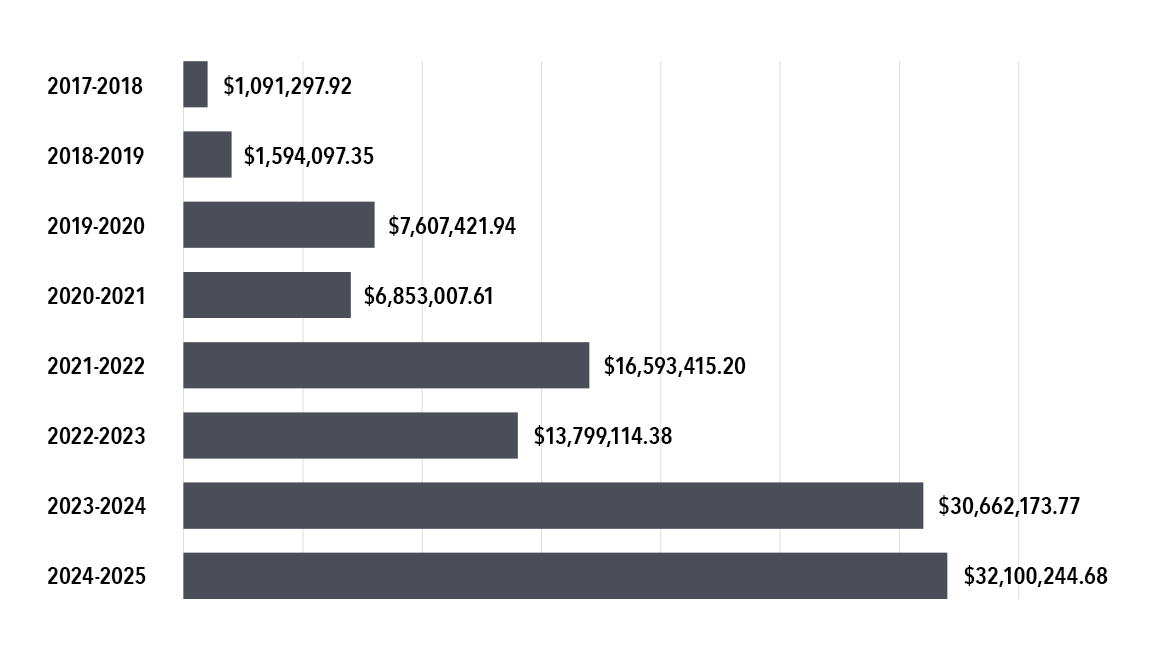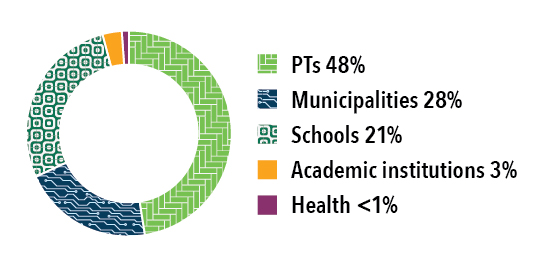2025 Canadian Collaborative Procurement Initiative year in review and look ahead
Overview of the Canadian Collaborative Procurement Initiative (CCPI) for the 2024 to 2025 fiscal year (April 1, 2024, to March 31, 2025) and future plans.
On this page
About the initiative
Public Procurement
Public Procurement accounts for about 13.4% of Canada’s gross domestic product. It amounts to over $300 billion annually. Of this amount, the federal government accounts for about $37 billion in spending on goods and services. The remaining 88% of public procurement is carried out by provinces, territories, as well as the broader public sector including municipalities, academic institutions, schools, and hospitals (MASH).
Canadian Collaborative Procurement Initiative
Established in 2015, CCPI supports public institutions in jointly purchasing goods and services. By combining their purchasing power, participants can reduce costs, streamline procurement processes, and achieve greater value. It offers ready-to-use procurement tools, at no cost and with no obligation. The initiative continues to support public institutions by providing access to a wide range of commodities, helping them work more efficiently to better serve Canadians.
Participants
CCPI participants can include:
- provinces and territories (PTs)
- municipalities, academic institutions, schools and hospitals (MASH)
- Canadian public health organizations
- Canadian aid agencies
- federal Crown corporations
- intergovernmental organizations
Benefits for buyers
Participants have access to more than 60 types of commodities. By choosing to purchase goods and services through CCPI, members can:
- fulfill their buying needs
- benefit from reduced costs
- achieve better value
- advance socioeconomic goals
- save administrative and legal costs
- avoid lengthy procurement processes
Buyers can purchase with confidence. All suppliers go through a rigorous prequalification process designed to ensure competitive pricing and best overall value.
Benefits for suppliers
A key focus of CCPI is to include commodities that consider supplier diversity, emphasizing opportunities for suppliers including:
- women-owned businesses
- Indigenous-owned businesses
- small and medium businesses
Through this initiative, these businesses have access to a widened market to sell their goods and services.
Collaboration across jurisdictions
Collaboration is a key element of CCPI. Ongoing engagement with procurement professionals from federal, provincial, territorial, and international jurisdictions helps:
- align priorities
- share best practices
- identify opportunities to strengthen procurement processes
These efforts are supported through working group sessions. Working groups bring together representatives from provinces, territories, and other eligible organizations participating in the initiative. CCPI also hosts knowledge-sharing sessions. In these sessions, experts in areas such as accessibility and sustainable procurement are invited to present tools, insights, and innovative approaches. These contributions promote awareness and help improve procurement practices across jurisdictions.
Achievements
Summary of CCPI activities and successes during the 2024 to 2025 fiscal year.
At a glance
CCPI continues to grow, with more participants joining and more commodities being offered. The initiative remains committed to meeting the evolving needs of its participants.
CCPI welcomed the addition of 2 federal crown corporations, 1 public health organization and several MASH sector organizations as participants.
As of March 31, 2025, there was a total of 483 participants, including:
- 12 PTs
- 2 Canadian public health organizations
- 2 federal crown corporations
- 467 MASH sector organizations
This represents a participation increase of 12% from last fiscal year. The number of actual participants is greater, as some institutions, such as school boards, act as administrative bodies for multiple participating schools.
Available commodities
The number of available commodities fluctuates from year to year. As some expire, others are combined or retendered under a different method of supply. As of March 31, 2025, 66 commodities were available, supplied by a selection of approximately 400 vendors. CCPI aims to include commodities that consider reducing the environmental impacts of procurement processes and increasing supplier diversity. Of the 66 commodities:
- 21 included sustainable or green procurement considerations
- 14 promoted participation opportunities of small and medium enterprises
- 18 were procurement set aside for Indigenous businesses
Newest commodities include:
- buoy lanterns and beacons
- beverages and rentals of dispensers
- hydrometric instruments
- naloxone nasal spray
- rechargeable batteries
- body-worn cameras and digital evidence management system
- hyper-realistic medical equipment and training
- ferromagnetic detection systems
- automated external defibrillators
Of these 9 new commodities:
- 5 considered green procurement aspects
- 3 targeted the participation of small and medium enterprises
- 1 was a set aside promoting the participation of Indigenous businesses
The Government of Canada announced it’s National Body Worn Camera (BWC) Program in fall 2020. It included $238.5 million in funding over 6 years. In support of the BWC Program, Public Services and Procurement Canada (PSPC) conducted a competitive procurement process on behalf of the Royal Canadian Mounted Police (RCMP) to equip front-line police officers. The RCMP began deploying the BWC and digital evidence management system (DEMS) to officers in November 2024. For the first time, CCPI participants, such as provincial and municipal law enforcement organizations, can now leverage this contract and submit service request orders for:
- combined BWC and DEMS
- DEMS-only user
- cellular enablement
- live streaming
- content storage
Results
Since the inception of CCPI, participation numbers have kept increasing. This reflects the initiative’s growing popularity and success. This consistent growth underscores sustained engagement and investment in the initiative. During the 2024 to 2025 fiscal year, CCPI participants collectively spent $32.1 million. This is a 5% increase over the previous year, consistent with the steady growth observed over the years (Figure 1).
Figure 1: Evolution of CCPI overall spending by fiscal year from 2017 to 2018 to 2024 to 2025.

Figure 1: Text version
| Fiscal Year | Total purchase |
|---|---|
| 2017 to 2018 | $1,091,297 |
| 2018 to 2019 | $1,594,097 |
| 2019 to 2020 | $7,607,421 |
| 2020 to 2021 | $6,853,007 |
| 2021 to 2022 | $16,593,415 |
| 2022 to 2023 | $13,799,114 |
| 2023 to 2024 | $30,633,334 |
| 2024 to 2025 | $32,100,244 |
As observed in previous years, P25 portable and mobile radio equipment continues to be the most popular commodity (Table 1). It consistently represents one-third of the total sales volume for CCPI. This underscores its sustained significance and robust demand in the market. Office supplies remained the second-highest commodity by expenditure, experiencing a notable increase of 47%. This rising trend across public administration highlights the importance of maintaining efficient procurement strategies in this category.
| Commodity name | Total expenditure |
|---|---|
| P25 portable and mobile radio equipment | $13,244,814 |
| Office supplies | $9,267,288 |
| Commercial tires | $5,774,112 |
| Office paper | $1,191,177 |
| Plumbing and heating supplies - Western region | $795,291 |
| Electronic fingerprinting devices | $377,959 |
| Roadside oral-fluid screening device | $327,683 |
| Medical supplies and equipment | $279,822 |
| Pursuit tires | $250,587 |
| Motorola radio | $231,909 |
| Digitization services | $132,470 |
| Into-plane aviation fuel | $125,635 |
The total amount spent on goods purchased by participant type for the most popular commodities are as follows:
- into-plane aviation fuel:
- municipalities: $125,635
- total spending: $125,635
- digitization services:
- municipalities: $132,470
- total spending: $132,470
- Motorola radio:
- municipalities: $105,157
- PTs: $126,752
- total spending: $231,909
- pursuit tires:
- municipalities: $203,048
- PTs: $47,540
- total spending: $250,587
- medical supplies and equipment:
- municipalities: $9,825
- PTs: $269,997
- total spending: $279,822
- roadside oral-fluid screening device:
- municipalities: $149,615
- PTs: $178,068
- total spending: $327,683
- electronic fingerprinting devices:
- municipalities: $342,349
- PTs: $35,610
- total spending: $377,959
- plumbing and heating supplies - Western region:
- academic institutions: $180,941
- municipalities: $31,734
- PTs: $398,823
- schools: $183,793
- total spending: $795,291
- office paper:
- academic institutions: $228,256
- health: $234
- municipalities: $4,970
- PTs: $326,493
- schools: $631,225
- total spending: $1,191,177
- commercial tires:
- academic institutions: $1,886
- municipalities: $1,859,544
- PTs: $3,531,088
- schools: $381,594
- total spending: $5,774,112
- office supplies:
- academic institutions: $444,856
- health: $25,709
- municipalities: $79,672
- PTs: $3,062,199
- schools: $5,654,851
- total spending: $9,267,288
- P25 portable and mobile radio equipment:
- municipalities: $5,925,043
- PTs: $7,299,771
- total spending: $13,224,814
Spending by provinces and territories made up the largest share of purchases in 2024 to 2025, followed by municipalities and schools. Compared to last year, the proportion of spending by PTs decreased slightly, while spending by municipalities and schools increased. The share for academic and health institutions remained consistent. (Figure 2)
Figure 2: Percentage of total spending by participant type
Note: Percentages do not total 100% due to rounding.

Figure 2: Text version
| Participant type | Percentage |
|---|---|
| PTs | 48% |
| Municipalities | 28% |
| Schools | 21% |
| Academic institutions | 3% |
| Health | Less than 1% |
Participant survey
In fall 2024 we surveyed participants to gather insights on their experience and identify opportunities to enhance the initiative. The feedback provided valuable perspectives from engaged participants.
Key findings include:
- high satisfaction with CCPI offerings, especially regarding cost savings and administrative efficiency.
- strong interest in expanding the range of available commodities to better meet diverse needs.
- suggestions for clearer purchasing instructions, particularly for users with limited procurement experience: an opportunity to simplify and tailor guidance.
- calls for improved visibility of training resources, including information sessions, user guides, and Q&As, to support greater engagement and usage.
These insights will shape CCPI’s forward plans and ongoing efforts to enhance the overall user experience.
The year ahead: 2025 to 2026
Summary of what we are working on.
Upcoming commodities
A new procurement tool for roadside alcohol screening devices was awarded in April 2025. While these devices are not used as evidence in court, they may provide grounds for officers to request a more comprehensive test. To further support the federal government’s mandate priority to keep Canadians safe by (…) reinforcing law enforcement, a competitive procurement process for approved breath analysis instruments is planned for fall 2025. It will be added to CCPI offerings.
Laboratory reagents and chemicals were previously purchased and distributed by the Public Health Agency of Canada (PHAC). PHAC’s procurement mandate ended on March 31, 2025. CCPI will support the continuity of supply. National public health laboratories will be able to procure genomic sequencing reagents through our initiative.
Looking ahead, CCPI will continue to explore opportunities to expand the range of available commodities. We will consider participant needs and interests and proactive collaboration with internal procurement teams. To suggest a new commodity, you can contact the CCPI team directly or use the commodity interest form.